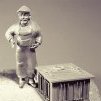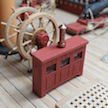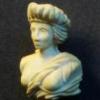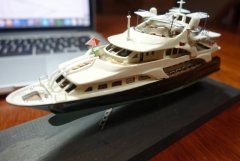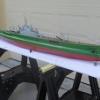-
Posts
993 -
Joined
-
Last visited
Reputation Activity
-
 Wintergreen got a reaction from Keith Black in HMS Sirius 1797 by paulsutcliffe - 1:48 - POF from NMM plans
Wintergreen got a reaction from Keith Black in HMS Sirius 1797 by paulsutcliffe - 1:48 - POF from NMM plans
Haha, about all that c**p in the background... you should see my photos. All kinds of weird stuff. I think it makes for interesting thoughts "wonder what he will use THAT for"
Oh, and also, very nice launches Paul. Keep it up.
-
 Wintergreen got a reaction from CiscoH in Kågen by Wintergreen - FINISHED - 1:30 - Swedish clinker-built cog work boat - SMALL
Wintergreen got a reaction from CiscoH in Kågen by Wintergreen - FINISHED - 1:30 - Swedish clinker-built cog work boat - SMALL
Hi guys,
the day is only half-gone here, but I just had to share this update with you.
First task for today was to clear a path to the shop... about 20cm/8" of snow overnight.
A short business trip took away a couple of days from the week, but back in the shop I made some progress.
Clinker/lapstrake is really something tricky to get right. Spiling and all that. In a later post I will show my trials and tribulations. On the trip I re-read H.A. Underhills chapter about clinker built boats, which was useful.
This far two full strakes are on. The scarphs are just plain butt ended with a backing piece on each. Joggled of course. Later each strake will be of three pieces.
Rubber bands and teak buns keep planks in place. I need to figure out some way to have the clamps not slipping off. Maybe a bit of tape will do the trick with enough friction.
Backing pieces have beveled edges for appearance. Should be pinned also, will see if I do that.
I am really enjoying this build. The result is far from perfect, but this is also my first time doing this. And since I have this first build as a practice run, my second will undoubtedly be better.
To be continued...
-
 Wintergreen got a reaction from CiscoH in Kågen by Wintergreen - FINISHED - 1:30 - Swedish clinker-built cog work boat - SMALL
Wintergreen got a reaction from CiscoH in Kågen by Wintergreen - FINISHED - 1:30 - Swedish clinker-built cog work boat - SMALL
Thanks for the likes. Glad to see that there are readers.
Anyway, the day went. Grandkid came, and that was that. Now, she's asleep, so some time to type.
About spiling and clinker, or lapstrake, builds. This is my first attempt at this, so there will probably be lessons learned and working experience later on. However, compared to a carvel laid hull where planks fit long side to long side, and you quite easily can force later planks to the edge of the former, the clinker style means the planks overlap each other and thus form a stepped style. You probably know this already. Otherwise Wikipedia will help you understand.
From my short experience there are some major challenges with this.
You cannot force the plank in place sideways, it has to sit nicely. If force is used the overlap will be out of bounds. Hence, every plank needs more or less spiling. These boats are usually all about the shape. You have the sheer as with a carvel build. But with clinker we are reminded by every single strake if the run of the plank is off in some way. No steelers nor drop planks. Not an option. Every. single. strake. runs all the way from stem to stern. The challenge is to get the run of the planks right when the width of the plank changes. Eyeballing, proportional dividers, measure and measure again, then try. If not satisfied - repeat.
Unfortunately it is not as simple as just divide every frame/mould with decided number of strakes, then it will look very odd. As can be seen in my previous pictures the first strakes get wider at stem/stern. After two-three strakes the opposite will be true. All planks are narrower at stem/stern to fit in.
How to solve the issue with spiling. Basically it is the same as for carvel builds. Chuck, Druxey and others have written articles about it.
First I tried with cardboard of approximately same thickness as the planks. Didn't work too well. Hard to handle due to small size. Hard to see adjacent strake.
For the third strake I remembered that, I think, Chuck used transparent tape. It sticks to the moulds, easy to see and mark. Lacking transparent tape I used the regular painters masking tape and found that it was semi-transparent. Good enough.
One thing I picked up from Underhill's book was his practice of gluing thin material to a backing piece of cardboard or paper. My plank material is thin enough to easily be cut by #11, it will however splinter just as easily. With a broad piece of masking tape on one side - problem solved.
That had another advantage I found out later.
Enough text, show me some photos...
Here the cardboard templates are used.
Now, masking tape instead.
Stick tape to a white surface. Connect the dots with a smooth line.
Move tape to plank material and cut. Backing tape on other side.
The advantage with the backing tape is that it can be used as template for the accompanying plank port/starboard. By the way, leave the backing tape as long as possible.
Meaning all the rough shaping is already done. Every plank still need shaping to fit, but saved some time still.
Bending is performed with a dab of water and heatgun. Birch is very adaptable and bends easily. It holds edges fairly well also as can be seen in a previous post.
That was it for today.
To be continued...
-
 Wintergreen got a reaction from kees de mol in Kågen by Wintergreen - FINISHED - 1:30 - Swedish clinker-built cog work boat - SMALL
Wintergreen got a reaction from kees de mol in Kågen by Wintergreen - FINISHED - 1:30 - Swedish clinker-built cog work boat - SMALL
Hi guys,
the day is only half-gone here, but I just had to share this update with you.
First task for today was to clear a path to the shop... about 20cm/8" of snow overnight.
A short business trip took away a couple of days from the week, but back in the shop I made some progress.
Clinker/lapstrake is really something tricky to get right. Spiling and all that. In a later post I will show my trials and tribulations. On the trip I re-read H.A. Underhills chapter about clinker built boats, which was useful.
This far two full strakes are on. The scarphs are just plain butt ended with a backing piece on each. Joggled of course. Later each strake will be of three pieces.
Rubber bands and teak buns keep planks in place. I need to figure out some way to have the clamps not slipping off. Maybe a bit of tape will do the trick with enough friction.
Backing pieces have beveled edges for appearance. Should be pinned also, will see if I do that.
I am really enjoying this build. The result is far from perfect, but this is also my first time doing this. And since I have this first build as a practice run, my second will undoubtedly be better.
To be continued...
-
 Wintergreen got a reaction from CiscoH in Kågen by Wintergreen - FINISHED - 1:30 - Swedish clinker-built cog work boat - SMALL
Wintergreen got a reaction from CiscoH in Kågen by Wintergreen - FINISHED - 1:30 - Swedish clinker-built cog work boat - SMALL
Hi guys!
Thanks for likes and comment.
Progress has been slow despite quite a few hours in the shop.
Why? Preparatory work.
It's like when all you want to do is to get that wallpaper up and instead you find yourself put up drywalls, fill screw holes, and then some sanding and after that more filling and more sanding. And just before you break the seal on the first roll of paper you realize that you need to prime the drywalls otherwise there isn't enough glue in the world that will keep your wallpaper up.
First, a picture to soothen the soul.
With a multi-tool equipped with a drum sander it was quite a quick job to get the skeleton close to shape.
However, to really get it down to specs took some grater care. When I gladly thought I was done prepping I cut the first strake out of cardboard.
Not happy with the run I turned to the book.
Yes, that man has like a lifetime experience of building boats. I have not.
While contemplating the planking I marked every plank on frame five (middle one). Then it appeared to me that the frame templates needed protection and with a sealed surface it would be easier to mark runs and all that.
So first a sealer then a layer of some very old Humbrol paint. Fascinating enough, the paint is something like 20 yrs old and still "usable".
By that I also put an end to this weekends affair in the shop.
In the background can be seen blanks for planking. 20 mm (3/4") in real world translates to 0,67 mm on my work bench. Not that they are EXACTLY 0,67 mm thick, more like 0,7 mm. Close enough me think.
To be continued...
-
 Wintergreen got a reaction from robdurant in HMS Bellona 1760 by SJSoane - Scale 1:64 - English 74-gun - as designed
Wintergreen got a reaction from robdurant in HMS Bellona 1760 by SJSoane - Scale 1:64 - English 74-gun - as designed
Mark, your Bellona is a very handsome model.
Great work.
-
 Wintergreen got a reaction from CaptainSteve in Kågen by Wintergreen - FINISHED - 1:30 - Swedish clinker-built cog work boat - SMALL
Wintergreen got a reaction from CaptainSteve in Kågen by Wintergreen - FINISHED - 1:30 - Swedish clinker-built cog work boat - SMALL
Hi guys,
the day is only half-gone here, but I just had to share this update with you.
First task for today was to clear a path to the shop... about 20cm/8" of snow overnight.
A short business trip took away a couple of days from the week, but back in the shop I made some progress.
Clinker/lapstrake is really something tricky to get right. Spiling and all that. In a later post I will show my trials and tribulations. On the trip I re-read H.A. Underhills chapter about clinker built boats, which was useful.
This far two full strakes are on. The scarphs are just plain butt ended with a backing piece on each. Joggled of course. Later each strake will be of three pieces.
Rubber bands and teak buns keep planks in place. I need to figure out some way to have the clamps not slipping off. Maybe a bit of tape will do the trick with enough friction.
Backing pieces have beveled edges for appearance. Should be pinned also, will see if I do that.
I am really enjoying this build. The result is far from perfect, but this is also my first time doing this. And since I have this first build as a practice run, my second will undoubtedly be better.
To be continued...
-
 Wintergreen got a reaction from reklein in Kågen by Wintergreen - FINISHED - 1:30 - Swedish clinker-built cog work boat - SMALL
Wintergreen got a reaction from reklein in Kågen by Wintergreen - FINISHED - 1:30 - Swedish clinker-built cog work boat - SMALL
Hi guys,
the day is only half-gone here, but I just had to share this update with you.
First task for today was to clear a path to the shop... about 20cm/8" of snow overnight.
A short business trip took away a couple of days from the week, but back in the shop I made some progress.
Clinker/lapstrake is really something tricky to get right. Spiling and all that. In a later post I will show my trials and tribulations. On the trip I re-read H.A. Underhills chapter about clinker built boats, which was useful.
This far two full strakes are on. The scarphs are just plain butt ended with a backing piece on each. Joggled of course. Later each strake will be of three pieces.
Rubber bands and teak buns keep planks in place. I need to figure out some way to have the clamps not slipping off. Maybe a bit of tape will do the trick with enough friction.
Backing pieces have beveled edges for appearance. Should be pinned also, will see if I do that.
I am really enjoying this build. The result is far from perfect, but this is also my first time doing this. And since I have this first build as a practice run, my second will undoubtedly be better.
To be continued...
-
 Wintergreen reacted to BANYAN in HMS Pegasus 1776 by Trussben - 1:48 - Swan-class sloop based on TFFM
Wintergreen reacted to BANYAN in HMS Pegasus 1776 by Trussben - 1:48 - Swan-class sloop based on TFFM
Turned out OK??? They look great Ben -nice neat work
cheers
Pat
-
 Wintergreen reacted to Mirabell61 in Eagle of Algier 1753 by Mirabell61 - FINISHED - 1:48 - Chebec - Nils Langemann
Wintergreen reacted to Mirabell61 in Eagle of Algier 1753 by Mirabell61 - FINISHED - 1:48 - Chebec - Nils Langemann
little update :
stb side now equiped with small sweep-port shutter doors (open mode), the port side will become closed sweep-ports...
Nils
-
 Wintergreen reacted to Mirabell61 in Eagle of Algier 1753 by Mirabell61 - FINISHED - 1:48 - Chebec - Nils Langemann
Wintergreen reacted to Mirabell61 in Eagle of Algier 1753 by Mirabell61 - FINISHED - 1:48 - Chebec - Nils Langemann
Hi Denis,
Thank you for your appreciative words,
that sounds great if you`ll be starting a populated model, I`ll be pleased to help where ever necessary, and following along.... (if you would need help)
Here a figurine I found on a British web site by coincidence, and its scale 1:48 as well .... Painting is in progress...., arms with sword and pistol will be added after painting
Nils
-
 Wintergreen got a reaction from druxey in Kågen by Wintergreen - FINISHED - 1:30 - Swedish clinker-built cog work boat - SMALL
Wintergreen got a reaction from druxey in Kågen by Wintergreen - FINISHED - 1:30 - Swedish clinker-built cog work boat - SMALL
Hi guys,
the day is only half-gone here, but I just had to share this update with you.
First task for today was to clear a path to the shop... about 20cm/8" of snow overnight.
A short business trip took away a couple of days from the week, but back in the shop I made some progress.
Clinker/lapstrake is really something tricky to get right. Spiling and all that. In a later post I will show my trials and tribulations. On the trip I re-read H.A. Underhills chapter about clinker built boats, which was useful.
This far two full strakes are on. The scarphs are just plain butt ended with a backing piece on each. Joggled of course. Later each strake will be of three pieces.
Rubber bands and teak buns keep planks in place. I need to figure out some way to have the clamps not slipping off. Maybe a bit of tape will do the trick with enough friction.
Backing pieces have beveled edges for appearance. Should be pinned also, will see if I do that.
I am really enjoying this build. The result is far from perfect, but this is also my first time doing this. And since I have this first build as a practice run, my second will undoubtedly be better.
To be continued...
-
 Wintergreen got a reaction from kees de mol in Kågen by Wintergreen - FINISHED - 1:30 - Swedish clinker-built cog work boat - SMALL
Wintergreen got a reaction from kees de mol in Kågen by Wintergreen - FINISHED - 1:30 - Swedish clinker-built cog work boat - SMALL
Hi guys!
Thanks for likes and comment.
Progress has been slow despite quite a few hours in the shop.
Why? Preparatory work.
It's like when all you want to do is to get that wallpaper up and instead you find yourself put up drywalls, fill screw holes, and then some sanding and after that more filling and more sanding. And just before you break the seal on the first roll of paper you realize that you need to prime the drywalls otherwise there isn't enough glue in the world that will keep your wallpaper up.
First, a picture to soothen the soul.
With a multi-tool equipped with a drum sander it was quite a quick job to get the skeleton close to shape.
However, to really get it down to specs took some grater care. When I gladly thought I was done prepping I cut the first strake out of cardboard.
Not happy with the run I turned to the book.
Yes, that man has like a lifetime experience of building boats. I have not.
While contemplating the planking I marked every plank on frame five (middle one). Then it appeared to me that the frame templates needed protection and with a sealed surface it would be easier to mark runs and all that.
So first a sealer then a layer of some very old Humbrol paint. Fascinating enough, the paint is something like 20 yrs old and still "usable".
By that I also put an end to this weekends affair in the shop.
In the background can be seen blanks for planking. 20 mm (3/4") in real world translates to 0,67 mm on my work bench. Not that they are EXACTLY 0,67 mm thick, more like 0,7 mm. Close enough me think.
To be continued...
-
 Wintergreen got a reaction from Reverend Colonel in Kågen by Wintergreen - FINISHED - 1:30 - Swedish clinker-built cog work boat - SMALL
Wintergreen got a reaction from Reverend Colonel in Kågen by Wintergreen - FINISHED - 1:30 - Swedish clinker-built cog work boat - SMALL
Hi again all,
another update.
The days I don't have to commute to work I save three ours of my life. Today I spent those hours at the yard :-)
Work continued with forming the pieces. First by file in my vice and then at the disc sander. Yes, it's the same lathe that doubles (or triples) as thickness sander also, except being a lathe...
Vaddoc, I now know what you mean with the glue. It took a thorough wipe with methylated spirits to get the glue off. The glue can come in handy in other applications perhaps.
When all parts were ready, the rabbet was next. I've seen from other logs how the builder has shaped a mat knife blade or similar to scrape mouldings and stuff. The rabbet here is quite straight forward, just some different angles, that's it.
As a first attempt the blade was squeezed in one of my clamps. If examined closely it can be seen that the rabbet takes a shortcut over the most acute bend on the stern. It was due to the clamps being too clumsy. Also, the tip of the blade broke off leaving an uneven rabbet as well.
(funny, what are my shoes doing in that picture...)
Option two. Two mount plates held together with wing nuts. Fairly easy I'd say. To fix the blade the torch came out to anneal it. After sharpening to an angle of ca 30 degrees the torch came to work again. This time the blade was quenched in water to be hardened again.
It is a bit fiddly to set the cut up, but then it is just to scrape away.
Now I appreciated my two sets of boat pieces because I fiddled a bit too much with the blade on the first set and had to go over the rabbets a second time.
With the other set I will be meticulous in setting the blade and then do all the rabbets at once.
For the weekend I might take a trip to my real boat or I might choose to stay at home in the yard. What do you reckon?
-
 Wintergreen got a reaction from Andrea Rossato in Kågen by Wintergreen - FINISHED - 1:30 - Swedish clinker-built cog work boat - SMALL
Wintergreen got a reaction from Andrea Rossato in Kågen by Wintergreen - FINISHED - 1:30 - Swedish clinker-built cog work boat - SMALL
Ahh...sawdust, finally!
Yes, John, I use the shop vacuum also. It's just that it is so noisy. Guys, thank you for the likes also.
After building the thickness sander, which by the way, works really well. Note to self.: I do need to countersink the machine screws a bit. The ones that hold the wedge. They scarred the wood, not too bad, but still ugly.
I went down to the hardware store and bought a ridiculously expensive spray glue. Well, it worked like a charm, so maybe, just maybe, it was worth the expense. This glue is intended for gluing the printouts to the wood. As can be seen in the first picture.
With them glued, I spent the better part of 30 min rummaging about to find a tool holder for the scroll saw. I knew it was in a bad place... finally found it. Next 15 minutes was spent trying to remember how to set the darn thing up. Google told me in the end.
While letting the scroll saw eat wood I pondered about how to file and sand those tiny little pieces and stopped myself right there. Like you eat an elephant of course. One at a time. See next picture.
Ed wrote: "when fatigue sets in... stop!" which what I did next. Before the halt, I had managed to release all parts from the slab of apple. Picture three.
One might wonder why there are two of everything. Well, to my knowledge, practice makes perfect. So, one set is for practice, and then I can do it right the second time on the other set of parts. Clever, huh?
Finally, I find it interesting how many tools you bring forth in time at all... don't you?
-
 Wintergreen got a reaction from Andrea Rossato in Kågen by Wintergreen - FINISHED - 1:30 - Swedish clinker-built cog work boat - SMALL
Wintergreen got a reaction from Andrea Rossato in Kågen by Wintergreen - FINISHED - 1:30 - Swedish clinker-built cog work boat - SMALL
Hi all,
Re the book; it covers a replica build of the original boat from 1900. Since these boats always were build without plans, the book contains no blueprints. The original boat was measured and from this they made a couple of plans, which are part of the book. Will show you later.
Now for todays update. In my earlier post I headed out to my shop in order to create some kind of thickness sander. So far, so good.
I have yet to try it out with sanding paper, but I think it might work. In the future there will probably be room for updates on some of the details of it.
The aluminium drum is held in place by squeezing only. Might need another way, but the friction seems good enough.
As you can se the height of the table is adjusted by a knurled knob attached to a M6 threaded rod. One full turn raises the table 1mm at the aft end. The drum is approximately 2/3 up the table. One full turn would then approximately lessen the space drum-table with 2/3 of a mm. (I guess).
The table is hinged at the front end.
I also need to build some dust extraction for it. But that will be quite easy, just some cover to stand over the whole unit with an outlet to attach a hose to.
We will see.
To be continued...
-
 Wintergreen reacted to Jim Lad in Meteor 1851 by Jim Lad - Scale 1:96 - Immigrant Ship
Wintergreen reacted to Jim Lad in Meteor 1851 by Jim Lad - Scale 1:96 - Immigrant Ship
Thanks, Bob.
Håkan, I'm thinking of employing some of the beetles to do the job!
John
-
 Wintergreen got a reaction from archjofo in Kågen by Wintergreen - FINISHED - 1:30 - Swedish clinker-built cog work boat - SMALL
Wintergreen got a reaction from archjofo in Kågen by Wintergreen - FINISHED - 1:30 - Swedish clinker-built cog work boat - SMALL
Hi guys,
the day is only half-gone here, but I just had to share this update with you.
First task for today was to clear a path to the shop... about 20cm/8" of snow overnight.
A short business trip took away a couple of days from the week, but back in the shop I made some progress.
Clinker/lapstrake is really something tricky to get right. Spiling and all that. In a later post I will show my trials and tribulations. On the trip I re-read H.A. Underhills chapter about clinker built boats, which was useful.
This far two full strakes are on. The scarphs are just plain butt ended with a backing piece on each. Joggled of course. Later each strake will be of three pieces.
Rubber bands and teak buns keep planks in place. I need to figure out some way to have the clamps not slipping off. Maybe a bit of tape will do the trick with enough friction.
Backing pieces have beveled edges for appearance. Should be pinned also, will see if I do that.
I am really enjoying this build. The result is far from perfect, but this is also my first time doing this. And since I have this first build as a practice run, my second will undoubtedly be better.
To be continued...
-
 Wintergreen got a reaction from Omega1234 in 28' Ranger-type Yacht by Mark Pearse - FINISHED - 1:12
Wintergreen got a reaction from Omega1234 in 28' Ranger-type Yacht by Mark Pearse - FINISHED - 1:12
Not that the items are very black, but excellent smithing nonetheless. ;-)
Missed your recent updates somehow. The bowsprit came out fine after your trimming.
-
 Wintergreen got a reaction from Omega1234 in Eagle of Algier 1753 by Mirabell61 - FINISHED - 1:48 - Chebec - Nils Langemann
Wintergreen got a reaction from Omega1234 in Eagle of Algier 1753 by Mirabell61 - FINISHED - 1:48 - Chebec - Nils Langemann
Thanks for the laugh Nils!
Please continue building!
-
 Wintergreen got a reaction from Omega1234 in Eagle of Algier 1753 by Mirabell61 - FINISHED - 1:48 - Chebec - Nils Langemann
Wintergreen got a reaction from Omega1234 in Eagle of Algier 1753 by Mirabell61 - FINISHED - 1:48 - Chebec - Nils Langemann
Nice work, Nils.
I directly thought of captain Jack Sparrow and his "able bodied crew" when I saw the figurines 😆
Spot on!
-
 Wintergreen got a reaction from Piet in Meteor 1851 by Jim Lad - Scale 1:96 - Immigrant Ship
Wintergreen got a reaction from Piet in Meteor 1851 by Jim Lad - Scale 1:96 - Immigrant Ship
Good progress there John despite everything around you.
I reckon that the space is limited at 1:96 even if you state the opposite. Reckon you have one of those mini yardsmen with an adze at your service...
-
 Wintergreen got a reaction from mtaylor in 28' Ranger-type Yacht by Mark Pearse - FINISHED - 1:12
Wintergreen got a reaction from mtaylor in 28' Ranger-type Yacht by Mark Pearse - FINISHED - 1:12
Not that the items are very black, but excellent smithing nonetheless. ;-)
Missed your recent updates somehow. The bowsprit came out fine after your trimming.
-
 Wintergreen got a reaction from mtaylor in Meteor 1851 by Jim Lad - Scale 1:96 - Immigrant Ship
Wintergreen got a reaction from mtaylor in Meteor 1851 by Jim Lad - Scale 1:96 - Immigrant Ship
Good progress there John despite everything around you.
I reckon that the space is limited at 1:96 even if you state the opposite. Reckon you have one of those mini yardsmen with an adze at your service...
-
 Wintergreen reacted to YankeeD in De Zeven Provinciën 1665 by YankeeD - Scale 1:50 - according to drawings by Mr. O. Blom - First wooden scratch ship build
Wintergreen reacted to YankeeD in De Zeven Provinciën 1665 by YankeeD - Scale 1:50 - according to drawings by Mr. O. Blom - First wooden scratch ship build
Well couldn't resist a short intermediate update. About halfway closing the portside.




